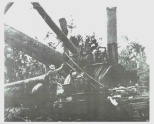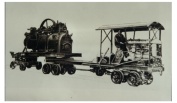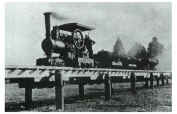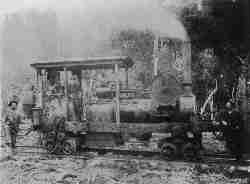
Chas Cook
 For the bush tramway of George King, located in the Tangowahine Valley, Northland,
Chas Cook, in 1910, built a special log hauler which, being self-propelled, also served as a locomotive. It
incorporated a 1904 Fraser-boilered steam log hauler and on top of the wheeled boiler, a two-cylinder winch was
placed with its gearing connected to the wheels via a chain drive. The winch also served to load the log buggies.
There was a two speed arrangement and the water tank was placed under the boiler.
This was a one-off monstrosity, or as one reporter stated - "an inartistic monster". Nevertheless it worked and
was later moved off to King's operation in the Awakino Valley where it worked from May 1911 until February 1912.
George King then took this locomotive south west to Mititai where he used it on another tramway.(Auckland
Weekly News)
For the bush tramway of George King, located in the Tangowahine Valley, Northland,
Chas Cook, in 1910, built a special log hauler which, being self-propelled, also served as a locomotive. It
incorporated a 1904 Fraser-boilered steam log hauler and on top of the wheeled boiler, a two-cylinder winch was
placed with its gearing connected to the wheels via a chain drive. The winch also served to load the log buggies.
There was a two speed arrangement and the water tank was placed under the boiler.
This was a one-off monstrosity, or as one reporter stated - "an inartistic monster". Nevertheless it worked and
was later moved off to King's operation in the Awakino Valley where it worked from May 1911 until February 1912.
George King then took this locomotive south west to Mititai where he used it on another tramway.(Auckland
Weekly News)
Dispatch Foundry
 This rail tractor is petrol powered but is included in this site about steam locomotives simply to illustrate the
progression Dispatch achieved from their ill conceived steam lokeys. Dispatch turned out around 45 of these tractors,
powered by petrol and diesel engines. Also, in time, one of these rail tractors was converted in to a steam
locomotive - how is that for progress!
This rail tractor is petrol powered but is included in this site about steam locomotives simply to illustrate the
progression Dispatch achieved from their ill conceived steam lokeys. Dispatch turned out around 45 of these tractors,
powered by petrol and diesel engines. Also, in time, one of these rail tractors was converted in to a steam
locomotive - how is that for progress!
(Dispatch Foundry)
One of the first rail tractors to be
built in about 1925, the machine was converted to steam in July of 1940 by fitting a Sentinel steam lorry
high-pressure vertical boiler and a Foden steam lorry set of compound cylinders. Later, in 1953, this locomotive
was re-boilered with a Garrett steam lorry boiler which lasted until the certificate expired in 1959. This lokey
now resides at the Pigeon Valley Steam Museum at Wakefield, near Nelson. (Maybe a photo soon)
Burrell
 Converted from a 1901 traction engine (Charles Burrell & Sons Ltd., Thetford, England #2418/1901) this 4-4-0
had its rear four wheels driven by chain from the crankshaft. It was converted around 1910 for Manson & Co.
of Tikokino in Hawkes Bay and they must have liked it as they transferred it to the South Island for their Lake
Brunner operation, where it worked until about 1923. After lying in the bush for nearly sixty years it was finally
scrapped in 1982.
Converted from a 1901 traction engine (Charles Burrell & Sons Ltd., Thetford, England #2418/1901) this 4-4-0
had its rear four wheels driven by chain from the crankshaft. It was converted around 1910 for Manson & Co.
of Tikokino in Hawkes Bay and they must have liked it as they transferred it to the South Island for their Lake
Brunner operation, where it worked until about 1923. After lying in the bush for nearly sixty years it was finally
scrapped in 1982.
(Auckland Weekly News)
Fraser & Tinne, Onehunga

![]() This steam locomotive had the distinction of being the very first to be built
in New Zealand. It was the work of Messrs Fraser & Tinne of Onehunga in 1872 and appears to have been built
around a Hornsby under-frame traction engine. It seems to have been inspired by a Chaplin engine that was used
by the Bay of Islands Coal Co. which Fraser & Tinne overhauled at one stage. It was, in fact a geared engine
with two vertical cylinders, mounted on the front of the smoke box, driving a cross-frame crankshaft thence by
gearing to the front wheels. The rear wheels of the 0-4-0 were driven by a coupling rod from the front set.
This steam locomotive had the distinction of being the very first to be built
in New Zealand. It was the work of Messrs Fraser & Tinne of Onehunga in 1872 and appears to have been built
around a Hornsby under-frame traction engine. It seems to have been inspired by a Chaplin engine that was used
by the Bay of Islands Coal Co. which Fraser & Tinne overhauled at one stage. It was, in fact a geared engine
with two vertical cylinders, mounted on the front of the smoke box, driving a cross-frame crankshaft thence by
gearing to the front wheels. The rear wheels of the 0-4-0 were driven by a coupling rod from the front set.
It was actually built for the Grahamstown & Tararu Tramway at Thames and worked there between 1872 and 1874
when the tramway ceased operation. It then appears to have been idle for some years until reported working on
foreshore reclamation work at Thames between 1879 and 1881. It was then overhauled by one T.T. Masefield and
performed some work for the NZ Timber Co, at Whangapoua, Coromandel. It then found its way to Guthrie &
Larnach on the west coast of Auckland where it was used at the Pararaha Mill on the Piha Tramway. It was fitted
with a collapsible funnel for working under overhanging rock ledges and through the tramway's tunnel. When the
timber market suffered a depression in 1886, all machinery was put up for sale and the rails uplifted. No offers
were received for the locomotive which had deteriorated badly in the corrosive coastal air and it was finally
abandoned on the Karekare beach to become something of a landmark before finally disappearing under the shifting
sands where it rests to this day.
![]() A further vertical boilered locomotive was constructed by Fraser & Tinne in 1874 going to the New Pymouth
Sash & Door Co. at Ngaere where it operated until 1894 before being shifted to their operation at Tariki Road
until 1904. From 1907 to 1912 the Derby Brothers at Toko, near Stratford, operated this lokey before going to
Goldfinch at Rangataua, National Park in 1915. In 1918 George Syme of Raetihi picked up the engine, using it
until 1926 when he transferred it to his operation at Tangiwai. Finally in the 1930s the Derby Brothers took it
back for use at Kopaki.
A further vertical boilered locomotive was constructed by Fraser & Tinne in 1874 going to the New Pymouth
Sash & Door Co. at Ngaere where it operated until 1894 before being shifted to their operation at Tariki Road
until 1904. From 1907 to 1912 the Derby Brothers at Toko, near Stratford, operated this lokey before going to
Goldfinch at Rangataua, National Park in 1915. In 1918 George Syme of Raetihi picked up the engine, using it
until 1926 when he transferred it to his operation at Tangiwai. Finally in the 1930s the Derby Brothers took it
back for use at Kopaki.
E.W. Mills, Wellington
![]() It has been reported that E.W. Mills of Lion Foundry, Wellington, built, in
1875 a vertical boilered 0-4-0 for Booth & Co. sawmillers of Clareville near Carterton. This was for a wooden
railed tramway. From a contemporary catalogue put out by Mills, this loco probably had a vertical boiler with
vertical cylinders driving a crankshaft thence by gearing to the rod-coupled wheels. A drawing of the catalogued
lokey is shown here.
It has been reported that E.W. Mills of Lion Foundry, Wellington, built, in
1875 a vertical boilered 0-4-0 for Booth & Co. sawmillers of Clareville near Carterton. This was for a wooden
railed tramway. From a contemporary catalogue put out by Mills, this loco probably had a vertical boiler with
vertical cylinders driving a crankshaft thence by gearing to the rod-coupled wheels. A drawing of the catalogued
lokey is shown here.
Mills went on to build two other locos that were used on bush tramways, both 0-4-0 tank locomotives, but these
were not geared engines.
Kincaid, McQueen & Co. Vulcan Foundry, Dunedin
The above shipbuilders and boiler makers built, in 1874, an 0-4-0 vertical boilered locomotive for Findlay & Howarth of Hokitika on the West Coast. As it was a vertical boiler it is likely that it may have been a geared loco, however records of this lokey are very sparce as it was written off, after two months in service, due to a runaway crash.
R.T.Watson, Charming Creek, West Coast
 The first attempt by Robert Watson to introduce a steam locomotive to his sawmill tramway, was constructed in 1909 from a 1905 Seagar Bros. vertical boiler.
Nothing much is known about this loco except that it had two 6/¼" cylinders and approved for 100psi pressure, was rated at 8hp.
It apparently was not successful but did last until the end of 1910, then sold for use as a pile driver at Westport.
The first attempt by Robert Watson to introduce a steam locomotive to his sawmill tramway, was constructed in 1909 from a 1905 Seagar Bros. vertical boiler.
Nothing much is known about this loco except that it had two 6/¼" cylinders and approved for 100psi pressure, was rated at 8hp.
It apparently was not successful but did last until the end of 1910, then sold for use as a pile driver at Westport.
The illustrated bush tram locomotive was converted from a Ruston & Procter portable boiler (#8698/1897). The boiler was mounted on a wooden frame
and a horizontal single cylinder engine was placed on top of the boiler. The flywheel balanced crankshaft was fitted with a sprocket and chain driving to a
layshaft which in turn drove two additional sprockets and chains which connected with sprockets on the two 4-wheel bogies. The man leaning against the font beam is Watson himself.
The loco was certified in May 1913 and continued in service until Febraury 1918.
In May of 1918, Watson introduced a second lokey, also fitted with a Ruston & Procter portable boiler. Presumably the construction was similar to that above and the boiler
certification expired in February 1921.
